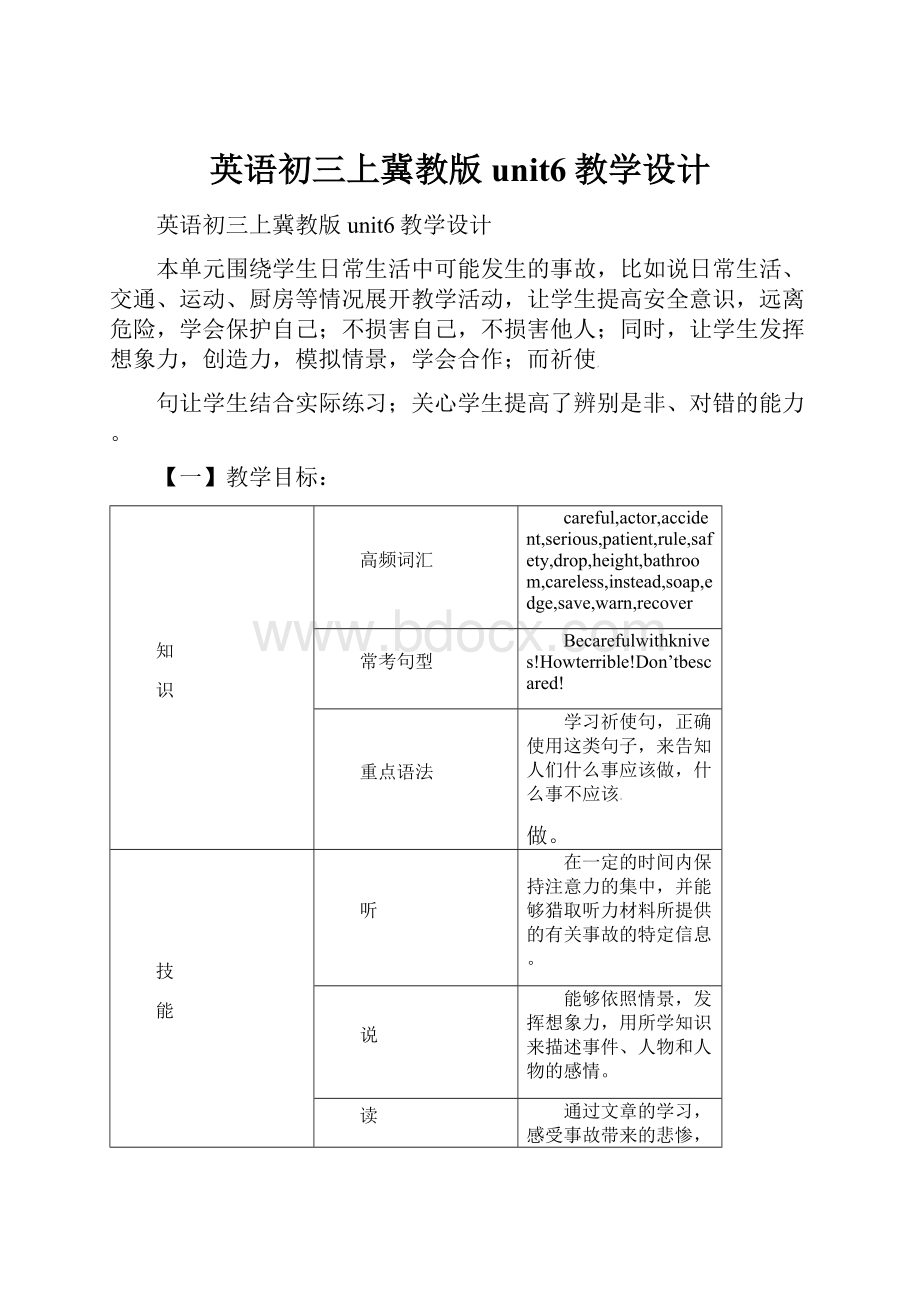英语初三上冀教版unit6教学设计.docx
《英语初三上冀教版unit6教学设计.docx》由会员分享,可在线阅读,更多相关《英语初三上冀教版unit6教学设计.docx(27页珍藏版)》请在冰豆网上搜索。

英语初三上冀教版unit6教学设计
英语初三上冀教版unit6教学设计
本单元围绕学生日常生活中可能发生的事故,比如说日常生活、交通、运动、厨房等情况展开教学活动,让学生提高安全意识,远离危险,学会保护自己;不损害自己,不损害他人;同时,让学生发挥想象力,创造力,模拟情景,学会合作;而祈使
句让学生结合实际练习;关心学生提高了辨别是非、对错的能力。
【一】教学目标:
知
识
高频词汇
careful,actor,accident,serious,patient,rule,safety,drop,height,bathroom,careless,instead,soap,edge,save,warn,recover
常考句型
Becarefulwithknives!
Howterrible!
Don’tbescared!
重点语法
学习祈使句,正确使用这类句子,来告知人们什么事应该做,什么事不应该
做。
技
能
听
在一定的时间内保持注意力的集中,并能够猎取听力材料所提供的有关事故的特定信息。
说
能够依照情景,发挥想象力,用所学知识来描述事件、人物和人物的感情。
读
通过文章的学习,感受事故带来的悲惨,引起我们对在灾难降临之际如何自救的思考。
写
通过写作训练,掌握用英语来描述情况的特征及发生的先后顺序,要有连贯性和逻辑性。
【二】教学设计:
在本单元的教学设计中,采纳了任务型教学途径,并借助了多媒体等教学辅助手段。
游戏和竞赛贯穿于整个教学过程,使学生保持浓厚的学习兴趣。
为本课设计了做游戏、图片鉴赏、竞猜、讨论、以及小组、讨论等多项活动,充分表达了“做中学”的新课程理念。
在实际教学中,引导学生围绕各种事故开展一系列活动,关心学生认识到安全的重要性;引出“怎么样使生活更安全”这一话题,促使学生参与积极讨论,以便于学生通过交流掌握交通多方面的情况。
Lesson41AfteranAccident
I.Teachinggoals:
Instructionalobjectives:
1.Helpthestudentsgraspthemainideaofthispassageandusefulexpressions.
2.Thestudentsusecreativerole-playtoreviewandlearnvocabularyaboutaccidents.
Educationalobjectives
1.Toimprovethestudents’abilityofco-operation,analyzingtheproblemsandcommunicationinEnglish.
2.Tostrengthenthestudents’consciousnesstoobeythetrafficrulesandlearnhowtoprotectthemselves.
II.Difficultpoints:
1.Usefulphrases:
accident,refuseacting,victim,pretend,warning,reporter,don’thaveto,haveanaccident
1.PleaseTakeCare!
2.Importantsentences:
2.Whydidn’tyoulistentomywarning?
3.Areyoubadlyhurt,Jenny?
III.Teachingaids:
multimedia,tape,recorder,flashcard
IV.Teachingprocedures:
Step1.Discussion
Cometo“ThinkAboutIt”.
Letthestudentsdiscussthethreequestionsinsmallgroupsandhelpthemtounderstandwhatisanaccident?
Whatshouldwedowhenwemeetanaccident?
Writedownthesuggestionsandtea
chthestudents
whattodowithanaccident.
Forexample:
Callthepolice.Call110/120.
stopthetraffictakecareofthevictim
(Encouragethestudentstofindmorewaystohelpothers,careabouttheothers.)
Step2.Review
Showthepicturesoftrafficsignstothestudentsonebyonequickly,andgetthestudentstoknowthemeaning.
Step3.Leading-in
Wemustknowsomesignsandwarnings,protectourselves.Nowlookatthepictures:
Whataretheydoing?
Didtheyhaveanaccident?
Readthetextandanswerthequestionsbelow:
1.Whataretheydoing?
2.WhatdoesJennywanttobe?
3.WhatdoBrianandDannywanttobe?
4.WhyisJennyangry?
(Letthestudentsanswerthequestionsquickly.Theteachercanhaveacompetitionamongthestudents.)
Step4.Exercise
1.Iwanttodosomething.我想演戏。
do此处的意思能够解释为“演出”。
e.g.Wedidonlycomediesthisseason.那个演季我们只演喜剧。
e.g.Mr.SmithwilldoHamlet.史密斯先生要扮演哈姆雷特。
2.Idon’thavetopretend.Iamherfriend.我没有必要装。
我确实是她的朋友。
(1)don’th
aveto
needn’tdosth.
don’tneedtodosth“不必做某事”的意思。
itisunnecessarytodosth.
e.g.Thereisalotoftimeleft.Wedon’thavegohurry.
时间还特别多,我们不必着急。
e.g.Shedoesn’tleaveatonce.
她没有赶忙离开。
(2)pretend意思是“假装,佯作”,后接动词不定式或宾语从句。
e.g.Whydon’tyoupretendtobeJenny’sfriend?
你假装詹妮的朋友不好吗?
e.g.Shepretendedtobestudyingwhenhismothercameback.
当妈妈回来时,她假装在学习。
3.Areyoubadlyhurt,Jenny?
詹妮,你伤得特别重吗?
badly此处的意思是“特别;在特别大程度上”,常与表示匮乏、需要等词语连用或与表示不良情况的词语连用。
例如:
Theschoolisbadlyinneedofhistoryteachers.这所学校急需历史老师。
Hewantstoseeherbadly.他特别想见到她。
badly还能够作“不好;不适或不能令人中意的方式”解。
例如:
Theyplayedfootballbadly.他们球踢得特别糟。
4.Itoldhertostop,butsherefused!
我告诉她停止,但她拒绝了!
refuse动词,意思是“谢绝,推辞;不准,不肯”。
Refuse+名词。
例如:
Herefusedthegift.他拒绝了礼物。
refuse+todo例如:
Thechildrenrefusedtolistentome.这些小孩子不肯听我的话。
Step5.Classactivity
Dividetheclassintogroupsofthree.Askeachgroupmembertotakeoneofthreerolesandactoutthedialogue.
Step6.Playaboutaccidents
老师能够提供不同事故的场景供学生参考。
在活动中让学生体验Howtorespondtoanaccident.
Step7.Summary
Step8.Project
1.Revisetheusefulexpressions.
2.Writeashortpassageabouthowtofaceanaccident.
Lesson42BeCareful,Danny!
I.Teachinggoals:
Instructionalobjectives:
1.Helpthestudentsgraspthemainideaofthispassageandusefulexpressions.
2.Teachthestudentshowtowriteareportaboutanaccident.
Educationalobjectives:
1.Toimprovethestudents’abilityofanalyzingtheproblemsandcommunicationinEnglish.
2.Tostrengthenthestudents’consciousnesstosafetyandlearnhowtoprotectthemselves.
II.Difficultpoints:
1.Usefulphrases:
careful,ceiling,seriousladder,injure,fault,ambulance,fallontopof
1.Isn’titbeautiful?
2.Importantsentences:
2.It’smyfault.
3.Becareful!
III.Teachingaids:
multimedia,tape,recorder,flashcard
IV.Teachingprocedures:
Step1.Revision
Actoutaplayaboutanaccident
Step2.Cometo“ThinkAboutIt”
Letthestudentsdiscussthethreequestionsinsmallgroups.Checktoseeifthestudentshavepreviewedthereadingasrequired.
Encouragesomestudentstotrytoanswerthequestions.Remembertogivelotsofpraiseforagoodeffort!
Step3.Newlesson
Playtheaudiotape.Havetheclassfollowthetapewhilelookingatthetext.
Step4.Fillinthefollowingform
ANACCIDENTREPORT
Who
What
When
Where
Why
Step5.Reading
Readthetextquicklyindifferentparts.
Step6.Exercise
Analyzethetext,learnsomeusefulexpressions.
1.Isn’titbeautiful?
难道它不漂亮吗?
此句是修饰疑问,它是为了取得一种修饰上的
效果而提出的,实际上相当于陈述句,不需要回答,但确信结构表否定,否定结构表确信。
e.g.Whatmoredoyouwant?
你还想要什么呢?
(即你不应该再想要什么了,应知足了。
〕
e.g.Isitimportant?
这件事对你重要吗?
〔即对你无关紧要,为必问呢?
〕
e.g.Haven’tyougotanythingbettertodo?
你难道没有更值得做的事吗?
〔即所以有〕
2.He’slyingonthefloor.他正躺在地板上。
lie不及物动词,意思是“躺,平躺;〔东西〕被平放;位于”,它的过去式、过去分词、v-ing形式分别是lay-lain-lying;
lie还能够作“说谎”解,过去式、过去分词为规那么变化。
3.It’smyfault,Mr.Jones.琼斯先生,那是我的错。
fault此处是“过错;过失”的意思,用来表示承担某事的责任。
4.Ididn’tlistentotheirwarning.我没有听他们的提醒。
listento意思是“听,倾听;听从,听信”。
e.g.You’renotlisteningtowhatIsay.你没有听我的话。
e.g.Ineverlistentowhatsalesmentellme.我从不听信推销员的话。
listen(out)forsth.意思是“留神等着听〔某声音〕。
”
e.g.Pleaselisten(out)forthephonewhileI’mhavingashower.
我洗澡时请你留心听着有没有来电话。
Step7.Classactivity
Imagineyouareajournalistandyourpartnerisawitnesstoanac
cident.Askhimorherquestionsbeginningwithwho,what,when,where,which,why.Reportittotheclass
(让每一组同学围绕以上要求各写一个句子,并把它们连成一个故事。
)
Step8.Summary
Step9.Project
Writeanaccidentreport.
假设你是警察,看到了一个事故并进行了处理,请你写下事故报告,其中包括who,when,where,why,how等。
Lesson43Brian’sInjury
I.Teachinggoals:
Instructionalobjectives:
1.Helpthestudentsgraspthemainideaofthispassageandusefulexpressions.
2.Teachthestudentshowtousetheimperativesentences.
Educationalobjectives:
1.Toimprovethestudents’abilityofanalyzingtheproblemsandcommunicationinEnglish.
2.Tostrengthenthestudents’consciousnesstodifferwhatisrightorwhatiswrong.
II.Difficultpoints:
1.Usefulphrases:
patient,safety,rule,drop,rush,bemadat,i
njury,recover,bounce,witness,icy,learnanewsafetyrule1.There’ssomethingwrongwith…
2.Importantsentences:
2.It’snothingserious.
3.Nevercatchafallingdinosaur!
III.Teachingaids:
multimedia,tape,recorder,flashcard
IV.Teachingprocedures
Step1.Revision
Actoutaplayaboutanaccident.Encouragethestudentstotrytoperform.Remembertogivelotsofpraiseforagoodeffort!
Step2.Leadingin
IsBrian’sinjuryserious?
Let’sseewhathappentoDannyandBrianthen?
Playtheaudiotape.Havetheclassfollowthetapewhilelookingatthetext.Thenanswerthefollowingquestions:
1.CanBrianwalk?
2.What’swrongwithBrianinfact?
3.HowdoesDannyfeel?
4.DoesBrianlearnanewsafetyruletoday?
Step3.Reading
Readthetextindifferentparts.
Step4.Exercise
Analyzethetext,thenyoucanlearnsomeusefulexpressions.
1.I’mnotmadatyou.我没有生你的气。
bemadat/withsb.“因……发怒/气愤;对……恼怒”。
与beangrywithsb.相同。
e.g.Shewasmadat/withhimforlosingthecar.她对他把汽车丢掉极为恼怒。
bemadon/aboutsb./sth.“对某人/某事物极为感兴趣或着迷”。
e.g.I’mmadon/aboutBruceLee.我对李小龙特别着迷。
2.Well,it’snothingserious.好了,没有什么严峻的。
serious此句中的意思是“严峻的”;它还能够作“严肃的;庄重的;认真的;真诚的”。
e.g.Mybrotherisaseriousperson.我弟弟是个严肃的人。
e.g.Areyoureallyseriousabouthim?
你真对他是认真的吗?
3.Nevercatchafallingdinosaur!
永久不要去接一个正在跌落的恐龙。
falling作定句。
单个的v-ing作定语一般置于其所修饰的名词之前,相当于一个定语从句,但较从句简单,故多用于口语中。
v-ing还能够作表语、状语和补足语。
e.g.Chinaisadevelopingcountry.=Chinaisacountrywhichisdeveloping.
中国是个进展中国家。
Thisfilmisveryexciting.这部电影特别令人激动。
e.g.Isawhimcrossingthestreet.我看到他在过马路
祈使句特点:
(1)没有主语。
(2)动词原型开头。
(3)否定句在句首加“Don’t”。
Model:
Youmustgettoschoolontime→Gettoschoolontime.
Heislateforschool.→Don’tbelateforschool.
Practice:
1.Youshouldgotobedearly.(祈使句)__________________________.
2.Talkinclass.(否定祈使句)___________________.
3.Doitlikethat.(否定祈使句)___________________.
Step5.Readapieceofnewsaboutanaccident.Andlearnsomeusefulexpressions.
Step6.Classactivity
小组讨论:
中学生应该做什么,不应该做什么。
讨论后请小组中的一个同学用祈使句把同学们的讨论结果记录下来。
写的最多的小组获胜。
Thethingsweshoulddoornotinourlife
Don’ttalkinclass!
Keepquiet.
Don’tbelate!
Getupearly!
Don’tspiteinpublic!
Dothingsbymyself!
Don’tlie!
Becareful!
Don’tdrawonthewall!
Lookbothwaysbeforeyoucross.
[设计说明]讨论的设定让学生展开联想,进展思维。
在应用中巩固了祈使句,同时也引导学生正确区分对与错、真与假,提高了他们辨别是非的能
力,对学生的良好行为规范起到潜移默化的教育作用。
Step7.Actoutthetextingroups
Step8.Summary
Step9.Project
Writemoreadviceaboutwhatyoungpeopleshouldandshouldnotdo.
Lesson44PleaseTakeCare!
I.Teachinggoals:
Instructionalobjectives:
1.Revisetheimperativesentences.
2.Learnhowtousethewordsandsentencesaboutaccidents.
Educationalobjectives:
1.Toimprovethestudents’abilityofprotectingthemselves.
2.Teachthestudentshowtokeepsafeinourlife.
II.Difficultpoints:
1.Usefulphrases:
height,careless,bellwaterslide
1.Don’tbecarelesswhenyougotorideyourbike!
2.Importantsentences:
2.Pleasetakecare!
3.Youmightinjureyourselforsomeoneelse.
III.Teachingaids:
multimedia,tape,recorder,flashcard
IV.Teachingprocedures.
Step1.Revision
搜集一些有关学生常见行为的图片,让学生看着图片用祈使句给出指令。
e.g.Don’tplayfootballinthestreet.
Alwayshelpothers.
Neverbelateforclass.
Don’tturnright
Don’tparkinthewrongplace.
Goahead!
Step2.Leadingin
Listentothetapeandlearntosingasongtogetherinclass.Tellthestudentstobecarefulwhentheydosomethings.
Step3.Lookatsomepicturesandtalkaboutwhatweshoulddowhenplaygames.
e.g.Becareful!
Don’ttoofast.Obeytherules!
Step4.Exercise
Analyzethetext,thenlearnsomeusefulexpressions.
1.Becarefulwhenyoujumpfromtoohighaheight.当你从太高处跳下时,要当心。
too是副词,意思是“过分;过度;太”,用于形容词和副词之前;当形容词修饰名词的单数形式时,冠词“a”放在形容词后面。
例如:
Hemadeto
olongaspeech.他讲话讲的太长了。
2.Sodon’tbecarelesswhenyougotorideyourbike.因此,当你骑车时,一定当心。
-less是个后缀,可与许多名词结合构成形容词,意思是“无;没有”。
-lessly用以构成副词。
-lessness用以构成不可数名词。
3.Youmightinjureyourselforsomeoneelse.你会伤着自己或别人的。
els